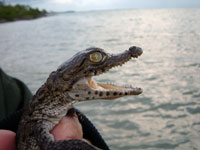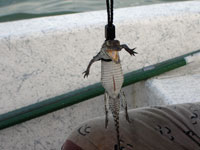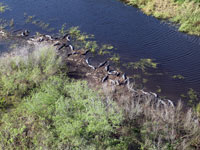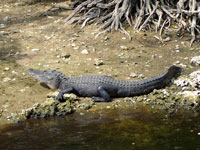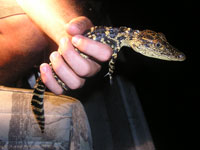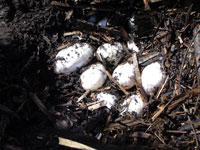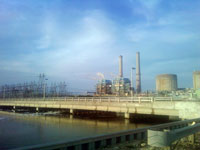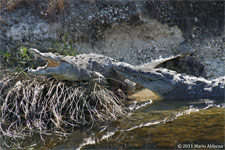Monitoring American Alligators and American Crocodiles as Indicators of Everglades Restoration
The American alligator (Alligator mississippiensis), perhaps the most recognized symbol of the Everglades, affects nearly all aquatic life in the ecosystem in some way. It is a top predator and an ecosystem engineer that builds holes, trails and nests which provide habitat for diverse plants and animals. While alligators are abundant throughout Florida in a variety of freshwater habitats, Everglades populations tend to be lower density and in poorer condition than those in the north.

The American crocodile (Crocodylus acutus) is a coastal species that occurs in parts of Mexico, Central and South America, the Caribbean, and south Florida. The crocodile was declared endangered in 1975, and although the population has significantly recovered and was reclassified as threatened in 2007, it continues to face issues related to habitat loss from development and effects of altered freshwater flow into estuaries.
Because of their key ecological roles and sensitivity to freshwater flow, alligators and crocodiles have been identified as a system-wide indicator of the health of Everglades environments. Long-term monitoring of these species contributes to an understanding of how the ecosystem is responding to the Comprehensive Everglades Restoration Plan (CERP). For alligators, we monitor relative density (number of alligators per kilometer), body condition (measured as length/weight ratio), and percent of alligator holes that are occupied. Crocodile performance measures are growth (cm/day) and survival rate. Monitoring data are combined and displayed on a map in "stoplight" colors to represent the status of the alligator and crocodile populations and progress toward meeting restoration goals.
Funding for the alligator and crocodile monitoring program comes from the following sources:
- The CERP Monitoring and Assessment Plan supports monitoring of alligator distribution, size and hole occupancy throughout the Greater Everglades; and growth and survival of crocodiles in North Key Largo, Biscayne Bay, and coastal areas of Everglades National Park.
- The National Park Service supports monitoring of crocodile growth and survival in northeastern Florida Bay, through the Modified Water Deliveries to Everglades National Park project.
- Florida Power & Light Company supports crocodile monitoring at the Turkey Point Power Plant site.
Images
Virtual Field Trip
Nesting Crocodiles and Hatchlings
Fact Sheets
The American Alligator: An Indicator Species for Everglades Restoration
American Crocodile Crocodylus acutus An Endangered Species Recovery in Progress [PDF] (English / Español)
Why Do We Need Environmental Monitoring for Everglades Restoration?
Select Publications
Bertone, S., A. Godahewa, S.A. Balaguera-Reina, V. Briggs-Gonzalez, and F.J. Mazzotti. 2023. First successful nest for an American crocodile (Crocodylus acutus) population on the West coast of Florida, United States. Oryx, 1-3. 10.1017/S0030605322001119
Balaguera-Reina S.A., N.D. Jennings, S.T. Godfrey, L. Brandt, B. Daykin, M.A. Squires, F.J. Mazzotti. 2022. Hematology and Biochemistry Reference Intervals for American Crocodiles (Crocodylus acutus) in South Florida. Frontiers in Veterinary Science. 9:919488. 10.3389/fvets.2022.919488.
Balaguera-Reina S.A., and F.J. Mazzotti. 2022. Belly up or belly down: Effect of body position on snout vent length and total length measurements in American crocodiles (Crocodylus acutus). Amphibia-Reptilia 43: 443-448 10.1163/15685381-bja10110.
Brandt, L.A., N.D. Jennings, M.A. Squires, C. Hachkett, C.D. Smith, and F.J. Mazzotti 2022. Hematology and Biochemistry Reference Intervals for American Alligator (Alligator mississippiensis) in South Florida, USA. J. of Wildlife Diseases, 58(2):457-464.
Mazzotti, F.J., S.A. Balaguera-Reina, L.A. Brandt, V. Briggs-Gonzalez, M. Cherkiss, S.C. Farris, and A. Godahewa 2022. Natural and anthropogenic factors influencing nesting ecology of the American crocodile in Florida, United States. Frontiers in Ecology and Evolution, 10: 10.3389/fevo.2022.904576
Hayman, R.B., R.G. Harvey, F.J. Mazzotti, G.D. Israel, and A.R. Woodward. 2014. Who complains about alligators? Cognitive and situational factors influence behavior toward wildlife. Human Dimensions of Wildlife: An International Journal, 19:6, 481-497.
Cherkiss, M.S., S.R. Romanach, and F.J. Mazzotti. 2011. The American Crocodile in Biscayne Bay, Florida. Estuaries and Coasts 34: 529-535.
Fujisaki, I., F.J. Mazzotti, R.M. Dorazio, K.G. Rice, M.S. Cherkiss, and B.M. Jeffery. 2011. Estimating trends in alligator populations from nightlight survey data. Wetlands 31:147-155.
Brandt, L.A., M.R. Campbell, and F.J. Mazzotti. 2010. Spatial distribution of alligator holes in the central Everglades. Southeastern Naturalist 9(3):487-496.
Mazzotti, F.J., G.R. Best, L.A. Brandt, M.S. Cherkiss, B.M. Jeffery, and K.G. Rice. 2009. Alligators and crocodiles as indicators for restoration of Everglades ecosystems. Ecological Indicators 9(6): S137-S149.
Mazzotti, F.J., R.G. Harvey, K.G. Rice, M.S. Cherkiss, and B.M. Jeffery. 2008. The Crocodilian Indicator in the Greater Everglades: 2006 Assessment Report. University of Florida, Fort Lauderdale Research and Education Center, Fort Lauderdale, Florida.
Smithem, J.L. and F.J. Mazzotti. 2008. Risk perception and acceptance of the American crocodile (Crocodylus acutus) in south Florida. Florida Scientist 71: 9-22.
Mazzotti, F.J., L.A. Brandt, P. Moler, and M.S. Cherkiss. 2007. The American Crocodile (Crocodylus acutus) in Florida: Recommendations for Endangered Species Recovery and Ecosystem Restoration. Journal of Herpetology. 41(1):122-132.
Mazzotti, F.J., M.S. Cherkiss, M.W. Parry, and K.G. Rice. 2007. Recent nesting of the American crocodile (Crocodylus acutus) in Everglades National Park, Florida, USA. Herpetological Review 38(3):285-289.
Cherkiss, M.S., H.E. Fling, F.J. Mazzotti, and K.G. Rice. 2004. Counting and Capturing Crocodilians. IFAS Publication Number CIR-1451. Institute of Food and Agricultural Science, Gainesville, FL: University of Florida - EDIS. (Español)
Palmer, M.L. and F.J. Mazzotti. 2004. Structure of Everglades alligator holes. Wetlands 24(1):115-122.
Brandt, L.A., F.J. Mazzotti, J.R. Wilcox, P.D. Barker, Jr., G.F. Hasty, Jr., and J. Wasilewski. 1995. Status of the American crocodile (Crocodylus acutus) at a power plant site in Florida, USA. Herpetological Natural History. 3:29-36.
Mazzotti, F.J. and L.A. Brandt. 1994. Ecology of the American alligator in a seasonally fluctuating environment. In: S.M. Davis and J.C. Ogden (Editors), Everglades: The Ecosystem and Its Restoration. St. Lucie Press, Delray Beach, FL, pp. 485-506.
Venetia Briggs-Gonzalez, Christophe Bonenfant, Mathieu Basille,Michael Cherkiss, Jeff Beauchamp, Frank Mazzotti. 2017. Life histories and conservation of long-lived reptiles, an illustration with the American crocodile (Crocodylus acutus).Journal of Animal Ecology 86.5 (2017): 1102-1113.
Mazzotti, Frank J., Brian J. Smith, Michiko A. Squires, Michael S. Cherkiss, Seth C. Farris, Caitlin Hackett, Kristen M. Hart, Venetia Briggs-Gonzalez, and Laura A. Brandt.2019. Influence of salinity on relative density of American crocodiles (Crocodylus acutus) in Everglades National Park: Implications for restoration of Everglades ecosystems..Ecological Indicators 102 (2019): 608-616.
Brandt, L.A., F.J. Mazzotti 2000. Nesting of alligators at the Arthur R. Marshall Loxahatchee National Wildlife Refuge. Florida Field Naturalist, 28(3): 122-126.
Brandt, L. A., Beauchamp, J. S., Jeffery, B. M., Cherkiss, M. S., & Mazzotti, F. J. (2016). Fluctuating water depths affect American alligator (Alligator mississippiensis) body condition in the Everglades, Florida, USA. Ecological indicators, 67, 441-450.
Waddle, J. H., Brandt, L. A., Jeffery, B. M., & Mazzotti, F. J. (2015). Dry years decrease abundance of American alligators in the Florida Everglades. Wetlands, 35(5), 865-875.
